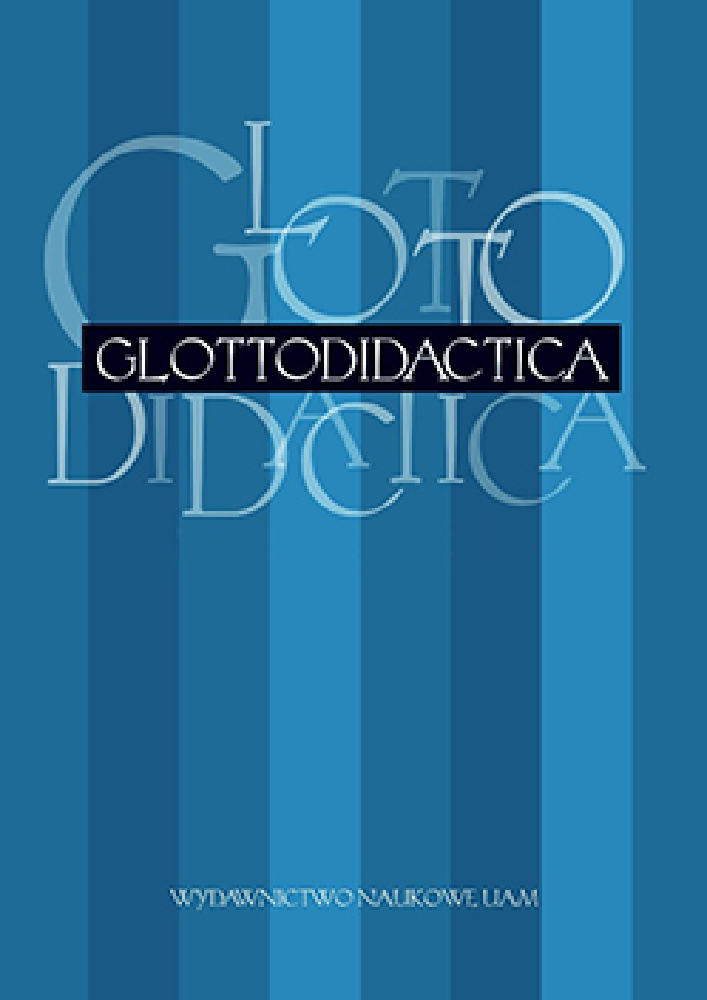Abstrakt
Pronunciation is an often-neglected aspect of language instruction. Teachers usually
place the blame on lack of time and resources, as well as curricular restrictions. However, in recent years, we have witnessed a proliferation of various tools that can be used to render work on different aspects of pronunciation much more interesting. In the present paper, we will focus on one particular technique: video dubbing. By examining the answers provided by the participants of a dubbing project conducted by the author of the present study, we will try to reflect on the potential advantages of such activities, and determine whether they are considered stimulating and effective by language learners.
Bibliografia
Baran-Łucarz, M. (2006). Prosto w oczy – fonetyka jako ‘Michałek’ na studiach filologicznych? In: W. Sobkowiak / E. Waniek-Klimczak (eds.). Dydaktyka fonetyki języka obcego w Polsce. Konin: Wydawnictwo PWSZ, 7–17.
Burston, J. (2005). Video dubbing projects in the foreign language curriculum. CALICO Journal, 23 (1), 79–92.
Charliac, L. / Motron, A.C. (2006). Phonétique progressive du français. Niveau avancé. Paris : CLE International.
Chiu, Y. (2012). Can film dubbing projects facilitate EFL learners’ acquisition of English pronunciation? British Journal of Educational Technology, 43 (1), pp. 24–27.
Danan, M. (2010). Dubbing projects for the language learner: a framework for integrating audiovisual translation into task-based instruction. Computer Assisted Language Learning, 23 (5), 441–456.
Gilet, G. (2012). Doublage d’un extrait de Volver d’Almodóvar et modification du scénario. Recherche et pratiques pédagogiques en langues de spécialité, 31 (2), 151–159.
Gajewska, E. (2011). Techniki nauczania języka obcego. Tarnów: PWSZ w Tarnowie.
Golshan, N.S. / Nosratzadeh, H. (2015). The impact of video dubbing, voice recording and shadowing tasks on Iranian EFL learners’ command of pronunciation. International Journal of Language and Applied Linguistics, 1, pp. 7–16.
Goodman, S. (2003). Teaching Youth Media: A Critical Guide to Literacy, Video Production, & Social Change. Nowy Jork: Teachers College Press.
Górska, W. (2009). Narzędzia web 2.0 w codziennej pracy nauczyciela języków obcych. Neofilolog, 33, pp. 197–204.
Hermeline, L. (2001). Enseigner la phonétique : oui, mais comment? Le français dans le monde, 318, pp. 27–28.
Hincks, R. / Edlund, J. (2009). Promoting increased pitch variation in oral presentation with transient visual feedback. Language Learning and Technology, 13 (3), pp. 32–50.
Huang, H.D. / Hung, S.A. (2015). Effects of a video-dubbing task: perspectives of EFL learners. In: J. Colpaert / A. Aerts / M. Oberhofer / M. Gutiérrez-Colón Plana (eds.). Proceedings of the seventeenth International CALL Research Conference, Tarragona, Universitat Rovira i Virgili,
—8 July 2015. Antwerp: University Press Antwerp. pp. 286–288.
Kondo, I. (2002). Video and learner enthusiasm: Stimulating personal interest as the first step towards autonomy In: A.S. Mackenzie / T. Newfield (eds.). Proceedings of the JALT CUE and TEVAL mini-conferences. Kyoto, Japan, Tokyo: JALT, pp. 83–86.
Kotuła, K. (2014). Les pratiques innovatrices en classe de langues. L’édition et la production des films dans l’enseignement de FLE. Studia Romanica Posnaniensia, 41 (3), pp. 47–61.
Luo, B. (2014). Evaluating a computer-assisted pronunciation training (CAPT) technique for efficient classroom instruction. Computer Assisted Language Learning, 29 (3), pp. 451–476.
Olson, D.J. (2014). Benefits of visual feedback on segmental production in the L2 classroom. Language Learning & Technology, 18 (3), pp. 173–192.
Parizet, M.L. (2008). Phonétique et Cadre Commun: propositions pour un cours de FLE. Synergies Espagne 1, pp. 113–122.
Qian, X. / Meng H. / Soong, F. (2016). Two-pass framework of mispronunciation detection & diagnosis for computer-aided pronunciation training. IEEE/ACM Transactions on Audio, Speech, and Language Processing, 24 (6), pp. 1020–1028.
Richards, J.C. / Renandya, W.A. (2002). Methodology in language teaching: An anthology of current practice. Cambridge: Cambridge University Press.
Rojczyk, A. (2011). Wykorzystanie programu do analizy mowy w nauce wymowy języka obcego. Nagłosowy kontrast dźwięczności w języku angielskim. In : M. Pawlak / B. Wolski (eds.). Wykorzystanie nowoczesnych technologii w dydaktyce języków obcych. Konin: Wydawnictwo
PWSZ, pp. 65–74.
Wachob, P. (2010). Using videos of students in the classroom to enhance learner autonomy. Teaching English with Technology, 11, pp. 18–28.
Wakefield, J.C. (2014). Dubbing as a method for language practice and learning. In: C. DeCoursey (ed.). Language Arts in Asia 2: English and Chinese through literature, drama and popular culture Newcastle upon Tyne: Cambridge Scholars Publishing, pp. 160–166.
Licencja
Autorzy
Autorzy tekstów przyjętych do publikacji w czasopiśmie Glottodidactica są zobowiązani do wypełnienia, podpisania i odesłania na adres redakcji umowy o udzielenie nieodpłatnej licencji do utworów, z zobowiązaniem do udzielania sublicencji CC.
Zgodnie z umową, autorzy tekstów opublikowanych w czasopiśmie Glottodidactica udzielają Uniwersytetowi im. Adama Mickiewicza w Poznaniu niewyłącznej i nieodpłatnej licencji oraz zezwalą na użycie sublicencji Creative Commons Attribution-NoDerivatives 4.0 International (CC BY-ND 4.0).
Autorzy zachowują prawa do dalszego, swobodnego rozporządzania utworem.
Użytkownicy
Zainteresowani użytkownicy internetu uprawnieni są do korzystania z utworów opublikowanych od 2015 roku w Glottodidactica pod następującymi warunkami:
- uznanie autorstwa - obowiązek podania wraz z rozpowszechnionym utworem, informacji, o autorstwie, tytule, źródle (odnośniki do oryginalnego utworu, DOI) oraz samej licencji;
- bez tworzenia utworów zależnych - utwór musi być zachowany w oryginalnej postaci, nie można bez zgody twórcy rozpowszechniać np. tłumaczeń, opracowań.
Do wszystkich tekstów opublikowanych przed 2015 r. prawa autorskie są zastrzeżone.
Inne
Uniwersytet im. Adama Mickiewicza w Poznaniu zachowuje prawo do czasopisma jako całości (układ, forma graficzna, tytuł, projekt okładki, logo itp.).





